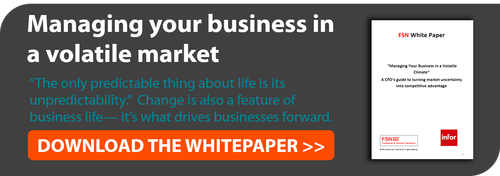
“The only predictable thing about life is its unpredictability” – Unknown
In the last decade, so many events had happened that brought unbridled change and volatility to the world’s economy. Business have been facing wildly fluctuating rates of decline and recovery across the globe. A “Growth markets forecast” done by Ernst & Young in 2013 has pointed out that insolvencies rose by 178% during 2008-9 recession in the US versus a 57% rose in the UK. Fortunately, during the past years, insolvencies has dropped fast and the rate in the US is falling 20% faster than that of in the UK. In addition to these changes and volatility, over-regulation, constant imposition from regulators and global standard-setters have brought complication and complexity to the systems and information that organisations need. This leads to the need to absorb and synthesise information so to manage risk more effectively. So, how companies should respond to volatility and what they need to do to enhance their competitiveness, financial performance, productivity in a volatile business climate?
There are 3 important aspects that organisation need to keep in mind when it comes to responding to uncertainties in volatile climate:
- Measure the right things
- Forecast more frequently and accurately
- Manage risk for competitive advantage
Below are discussions of how to do it effectively and efficiently:
Measuring the right things
The quality of an organisation’s data management and its key performance indicators (KPIs) are crucial to how an organisation respond to change and market volatility. As such, these helps the organisation align their business process with its strategy. Unfortunately, it is hard to view the overall strategy and check its integrity, especially for large and complex organisations. Too often, these organisations have too many KPIs and old KPIs can go unchallenged whilst new leading indicators of performance need to be developed at the same time. So, the tendency is to rely heavily on trusted finance indicators of performance rather than less familiar non-financial ones. The problem is, non-familiar indicators are often tightly linked with future finance performance. Henceforth, organisation need to measure both financial and non-financial KPIs in order to have better data management capability.
More frequent and accurate forecasting
When facing with a fragile global economy and increased volatility, increasing the frequency of forecasting, constantly testing the “what-if” scenarios, and assessing risks are important things to be done. In fact, sustainability growth is achieved depending on how accurate an organisational forecasting capability is. A majority of organisation are now clinging to traditional budgeting and forecasting method to indicate their principal performance, which lead them to nowhere but prevention to forecasting accuracy. In order to achieve forecasting accuracy, rolling forecasting methods are suggested. According to the report, “Forecasting with Confidence” from EIU/FPMG 2007, 40% of the surveyed organisation believe that they will increase their forecasting confidence using rolling forecasts method. The main reason is, according to FSN (2013), “by providing a comprehensive cross-functional view of the forecast enhances the quality and the robustness of the projection, thus improving confidence when navigating unprecedented volatility”.
Managing risk for competitive advantage
In a volatile economy, opportunities continually ebb and flow. The ability to carefully select opportunities to act ahead of agile competitor can help create a competitive advantage that is sustainable in the long term for businesses. However, alongside opportunities, greater risks are at present. Tackling risks can be done by adopting best practices, tools and technique as well as leverage an appropriate blend of organisational structure, process and technology. Moreover, organisations need to understand and quantified the nature of the risks while developing key risk indicators (KRIs) and risk mitigation measures to monitor and report on risk containment. Crucially, KRIs should be incorporated into forecasts and reported together with the financial results to which they relate.
In extremely volatile market, organisations should look beyond limited sensitivity analysis in their planning and forecasting to better risk management. Being managed in the right way, risk management can give organisation better opportunity to pursue new products, business acquisitions and ventures in foreign markets with confidence.
In conclusion, organisations’ management processes are normally insufficient to turn volatility to advantage. That means, few organisations are able to drive growth and sustainability consistently. In addition, management teams are more risk averse in a fragile economy. However, keeping your business alive in a volatile climate is a doable job. As such, organisations can focus on measuring the right things, forecasting accurately and managing risks to its advantage and achieve their goals
Read the whitepaper “Managing your business in a volatile climate: A CFO’s guide to turning market uncertainty into competitive advantage” to find out more on how should companies respond to volatility.

 English
English  Vietnamese
Vietnamese 
